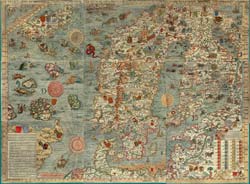An earthquake shook the South-West Pacific islands of Ambrym and Pentecost on 26 November 1999. It was the strongest thrust event ever recorded in central Vanuatu. Offshore and onshore data gathered by IRD researchers yielded clues as to the tectonic movements involved in the earthquake. A resulting model of the rupture mechanism showed that in this area of Vanuatu, slipping motions of the Australian oceanic plate under the Pacific plate are blocked to the West, which generates strong stresses to the
Rice-Los Alamos team find remarkable similarity between data from sky and computer
In the early years of the Space Age, astronomers made the startling discovery that short, transient flashes of gamma rays occurred randomly in the sky every night. Only within the past decade have scientists uncovered evidence to associate gamma-ray bursts with the death cries of massive stars from the edge of the universe. But they’ve had very few clues about how a “hypernova” or “collapsar” might
“Regime shifts” are infrequent, large changes in oceanic conditions that spread through the food web. Depending on dynamics of the ecosystem, the response of a biological organism to some external forcing can be smooth, abrupt, or discontinuous.
In a paper published in the current issue of Progress in Oceanography, Dr. Jeremy Collie, University of Rhode Island Graduate School of Oceanography, Dr. Katherine Richardson, University of Arhus, Denmark, and Dr. John Steele, Woods Hole Oceanograph
Among the most accomplished navigators in the animal kingdom, sea turtles often migrate across thousands of miles of open ocean to arrive at specific feeding and nesting sites. How they do so, however, has mystified biologists for over a century.
Now, new findings by a research team headed by Drs. Kenneth and Catherine Lohmann, marine biologists at the University of North Carolina at Chapel Hill, indicate that the navigational ability of sea turtles is based at least partly on a “magnetic ma

Scientists at the National Space Science and Technology Center (NSSTC) in Huntsville, Ala., are using information gleaned from NASA satellites, aircraft and field research to better understand dynamics behind tornadoes, lightning, hurricanes and other destructive forces of nature.
“A better understanding of severe weather can help people year-round,” said Dr. Tim Miller of the Global Hydrology and Climate Center (GHCC) in Huntsville. “The Center is conducting a variety of unique research pr

The ornate map, seemingly crude by today’s standards, depicts sea monsters off the coast of Scotland, sinking galleons, sea snakes, and wolves urinating against trees.
When oceanographers from Plymouth Marine Laboratory and the University of Rhode Island compared a large group of swirls, shown on the chart off the east coast of Iceland, with thermal images from an Earth observation satellite they found the swirls corresponded almost perfectly with the Iceland-Faroes Front – where the Gulf